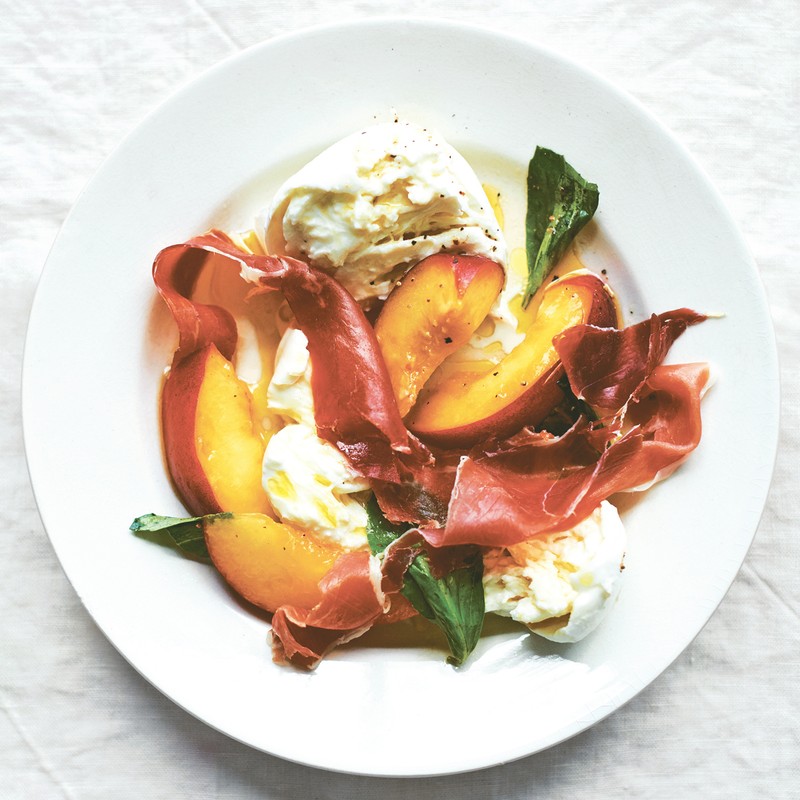How To Cook Like You’re In The South Of France

Provence is the region of France that speaks to me the loudest
I love France and all French food, but there’s something about Provence that is delightfully different – it has its own identity. What I like about the food of Provence is that it feels so Italian – it’s about vegetables and olive oil more than veal stock and butter – and that it invites a simple, seasonal approach to cooking.
Many great food writers have fallen for Provence
I’m inspired by Patience Gray (Honey from a Weed especially, it’s my favourite cookbook), anything by Elizabeth David, Richard Olney for his profound appreciation of what makes Provençal food tick, and Alice Waters for opening dream restaurant Chez Panisse in Berkeley, California.
I’m on a quest to buy decent vegetables in season
In London there are various speciality suppliers that mean I am slightly spoiled for choice. Natoora is a wholesale operation that supplies my restaurant; it also does a bit of retail through Ocado and is your best bet for French and Italian fruit and vegetables. I live in Hackney and often shop at the fantastic Turkish-run greengrocers. Failing that, Waitrose is pretty good.
The cooking style at Sardine is ‘more farmhouse than fine-dining’
I hope that none of the cooking techniques found in the cookbook are too complicated or, God-forbid, ‘cheffy’. The way I cook is pretty old-school – wooden spoons rather than Thermomixes. I always find that trying to emulate the way one’s grandmother would go about it is a good approach. Less faff, more soul.
A Grande Bouffe, loosely translated, is a ‘Big Feast’
I celebrate Grande Bouffe at the end of each chapter. The idea is to try to replicate those dreamy big-format family meals, or a village festival in the south of France somewhere. These are meals that we cook at the restaurant, which makes a nice change from messing around with the usual a la carte menu, and allows us the opportunity to cook something that is meant to be shared with family and friends.
Summer is as good a time as any to celebrate Provence
Southern French cooking is often at its simplest and best when the tomatoes are in season and the sun is shining. That said, it’s been really interesting to explore what they cook in the south of France when the tourists go home, and the ‘Autumn’ and ‘Winter’ chapters have some of my favourite recipes in them. Don’t put the book away when the summer ends!
Feeling inspired? Here are four Provençal recipes – from starters to pud – from Alex’s new book…
Mozzarella, Peaches & Ham
Although hardly a recipe, more of an assembly, this is summer ‘cooking’ at its simplest. As the success of this dish hinges on the quality of the ingredients, wait until the peaches are perfectly ripe and sweet. I prefer buffalo mozzarella from Campania, the fresher the better, but this would also be nice with fresh ricotta. You could also substitute nectarines in place of the peaches.
INGREDIENTS (Serves 4)
4 x 125g balls of buffalo mozzarella
2 peaches
Olive oil
Lemon juice
12 basil leaves
4 slices of cured ham (prosciutto if possible)
Sea salt and freshly ground black pepper
METHOD
1. Tear the mozzarella with your hands into large pieces and scatter over a large plate or serving dish.
2. Halve, stone and slice the peaches into sixths or thick slices. Dress the peaches lightly with a tiny splash of olive oil and just enough lemon juice to balance out the sweetness of the peaches. Season with salt and black pepper.
3. Toss the basil gently and briefly with the dressed peaches, then arrange on the serving plate with the mozzarella. Drizzle the cheese with your best olive oil. Finally, drape the ham lovingly over the top.
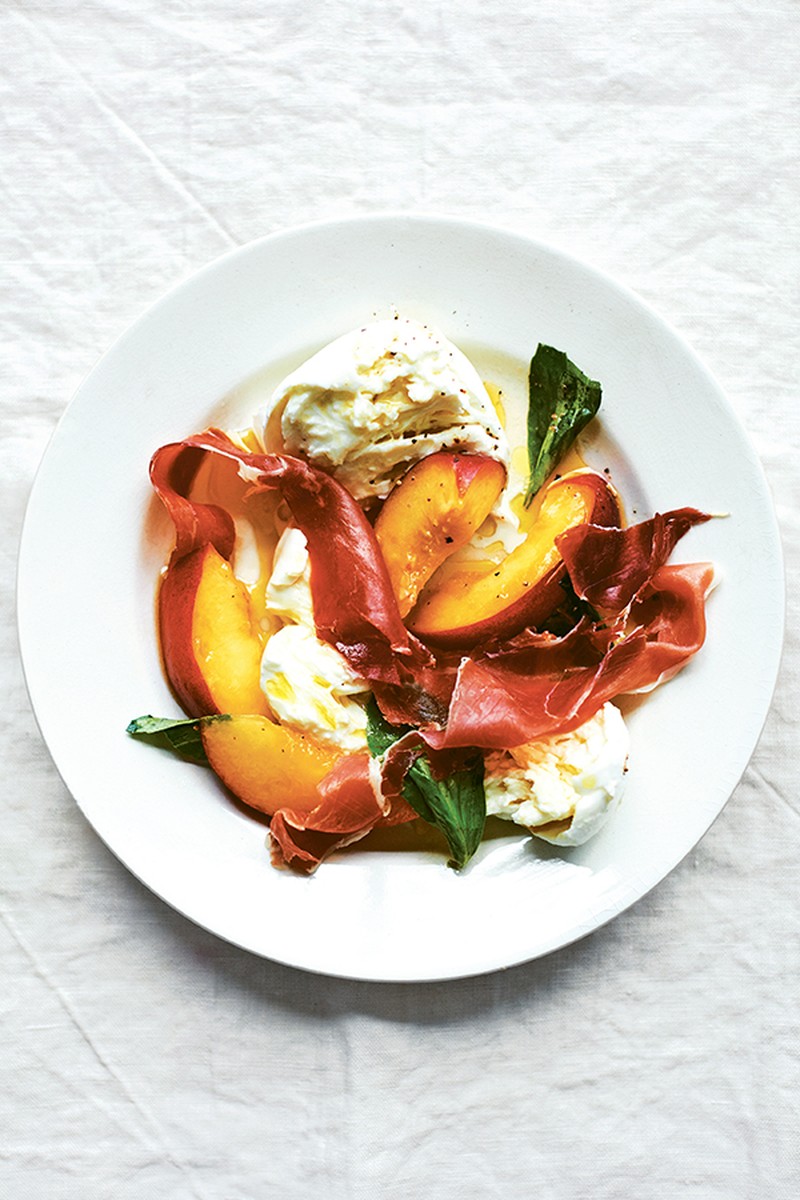
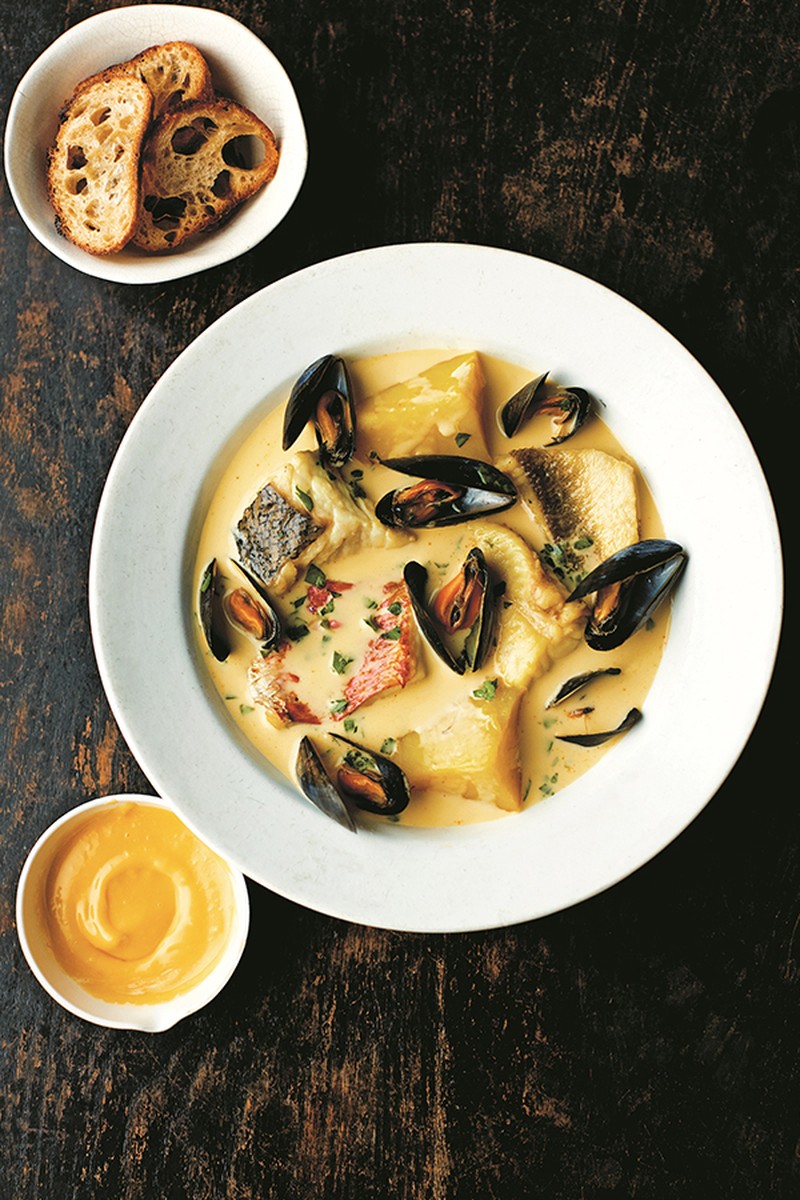
Bourride
A cousin of bouillabaisse, bourride is a rich, saffron-spiked fish stew thickened with aïoli. It’s somehow less riotous than bouillabaisse, but no less flavourful, and the saffron/aïoli combination is rich and deeply satisfying. A bourride needs its accoutrements. Croûtons spread with extra aïoli, make useful vehicles for excessive amounts of garlic, and are fun to float around on top of the stew, soaking up the sauce. Waxy potatoes cooked in the broth offer some respite from the richness.
INGREDIENTS (Serves 4)
For the stew:
1 medium onion, roughly chopped
2 celery stalks, roughly chopped
1 small head of fennel, roughly chopped
1 small leek roughly chopped into rounds
6 garlic cloves, peeled
Olive oil
A few parsley stalks
1 thyme sprig
1 bay leaf
2 strips of orange peel (use a vegetable peeler)
1 tsp black peppercorns
1 tsp fennel seeds
A pinch of saffron
2 fresh tomatoes, blanched, peeled and roughly chopped
1kg fish heads and bones, gills removed, washed well (gurnard and red mullet bones make the most delicious stews)
A glass of dry white wine
200g waxy potatoes, peeled and cut into chunks
Salt
For the aioli:
1 fat or 2 small garlic cloves, peeled and green sprout removed
1 tsp fine salt
2 egg yolks
200ml extra virgin olive oil
Juice of ½ lemon
For the croutons:
Some stale baguette
Olive oil
For the bourride:
150g monkfish, filleted weight
150g red mullet, filleted weight
150g oz gurnard, filleted weight
150g oz hake, filleted weight
200g mussels
A handful of parsley, chopped
A pinch of cayenne pepper
Sea salt and freshly ground black pepper
METHOD
1. Fry the roughly chopped vegetables and the whole garlic cloves slowly in olive oil, with a good pinch of salt, until they are soft. This should take at least 30 minutes.
2. Throw the herbs into the pan, then add the orange peel, peppercorns, fennel seeds and saffron. Cook, stirring, on a low heat to bring out the flavours of the spices.
3. When all is soft, sweet and aromatic, add the chopped tomatoes. Cook for 5 minutes over a medium–low heat, then add the fish bones, followed by the white wine. Cover with water.
4. Bring to the boil, reduce to a simmer, and cook for around 30 minutes, or until the bones have given up their flavour. As the fish cooks, skim off any scum that gathers on the surface of the stew.
5. Strain the stew into a clean pan, discarding the vegetables, herbs and fish bones to leave the liquid only. Next, cook the potatoes in the strained stew.
6. Remove the potatoes, taste for salt, adjust with more salt if necessary and set aside.
7. To make the aioli, crush the garlic with a good pinch of salt to a fine white paste in the mortar with the pestle. Add the egg yolks and emulsify as best you can. Add the olive oil very slowly, at first drop by drop, then in a slow stream. As the emulsion starts to thicken, add a few drops of lemon juice and a few of water, then continue with the oil. It’s important to add the lemon juice and water gradually to avoid splitting the mixture. When all the oil is incorporated, taste the aioli for salt and lemon juice to find a nice balance. You shouldn’t be able to taste any raw egg. If you can, the aioli needs more oil. If it looks a little too thick and ‘rebounds’ when you try to dip something into it, it needs another splash of water.
8. Make the croutons by cutting a stale baguette into thin rounds. Rub with olive oil, and toast gently in a low oven until crunchy.
9. To make the bourride, fillet and pin-bone the fish if it hasn’t been already done by your fishmonger. Cut each fish into four equal pieces and season with salt. Clean the mussels, washing well in cold water, scraping well, and discarding any that remain open when tapped.
10. Season the fish with salt and poach very gently in the hot stew, covered with a lid. If some pieces are thicker than others, add the thickest bits first, and the thinnest bits last. Just before the fish is cooked, add the mussels and the cooked potatoes. Test to see if the fish is cooked: insert a thin skewer into the thickest piece of fish. If the skewer passes through with no resistance, the fish is cooked. Make sure the mussels are open, discard any that remain closed.
11. Carefully scoop out all of the fish, shellfish and potatoes from the pan and divide between individual bowls or, better still, place on one large serving platter. Keep warm while you finish the stew.
12. Take some aioli, about a tablespoon per person, and put it in a decent-sized bowl. Slowly whisk in a ladleful of the stock, until you have a thick aioli soup. Off the heat, pour this tempered aioli back into the hot fish soup, whisking furiously as you go. Return to a very low heat or a bain marie over some simmering water. Bring the bourride up to eating temperature slowly. Take extreme care not to boil the soup at this stage or the emulsion will split. You are looking for a smooth, velvety finish to the soup. If the worst happens, whisk in a little more aioli using the same method, and this should smooth things over.
13. Pour the bourride over the fish and potatoes, and sprinkle with chopped parsley and some cayenne pepper. Serve with the croutons and bowls of extra aioli.
Panna Cotta & Cherries Poached In Pastis
Poaching cherries in pastis results in a deep, dark crimson liquid. Sweet, sour and with a heady aniseed hit, it’s something syrupy, exotic and vivid to pour around your white vanilla-speckled set cream. Any leftover cherry liquor is a treat when mixed with some crémant (or champagne, darling) for a sort of southern Kir Royale.
INGREDIENTS (Serves 4)
For the panna cotta:
600ml double cream
1 vanilla pod or 1 tsp vanilla extract, preferably one with little black seeds in it
Rind of ½ unwaxed lemon, peeled with a vegetable peeler
1½ leaves of gelatine
75ml whole milk
75g cup icing sugar
For the poached cherries:
100ml cup pastis
100ml cup water
50g cup caster sugar
1 thyme sprig
400g finest French dark red cherries, stalk removed and pitted
METHOD
1. Pour 450ml cups of the cream into a pan. Add the vanilla and lemon rind, then bring to the boil. Turn the heat down and simmer until the cream has reduced by one-third. Remove the cooked lemon rind. If using real vanilla, remove the vanilla pod, split it lengthways and scrape the seeds back into the cream.
2. Soak the gelatine in the cold milk for about 15 minutes or until soft. Remove the gelatine, bring the milk to a boil, then return the gelatine to the milk and stir until dissolved.
3. Pour the milk and gelatine mixture through a sieve (strainer) into the hot cream, stir, then allow to cool. Lightly whip the remaining cream with the icing sugar and fold into the cooled cooked cream.
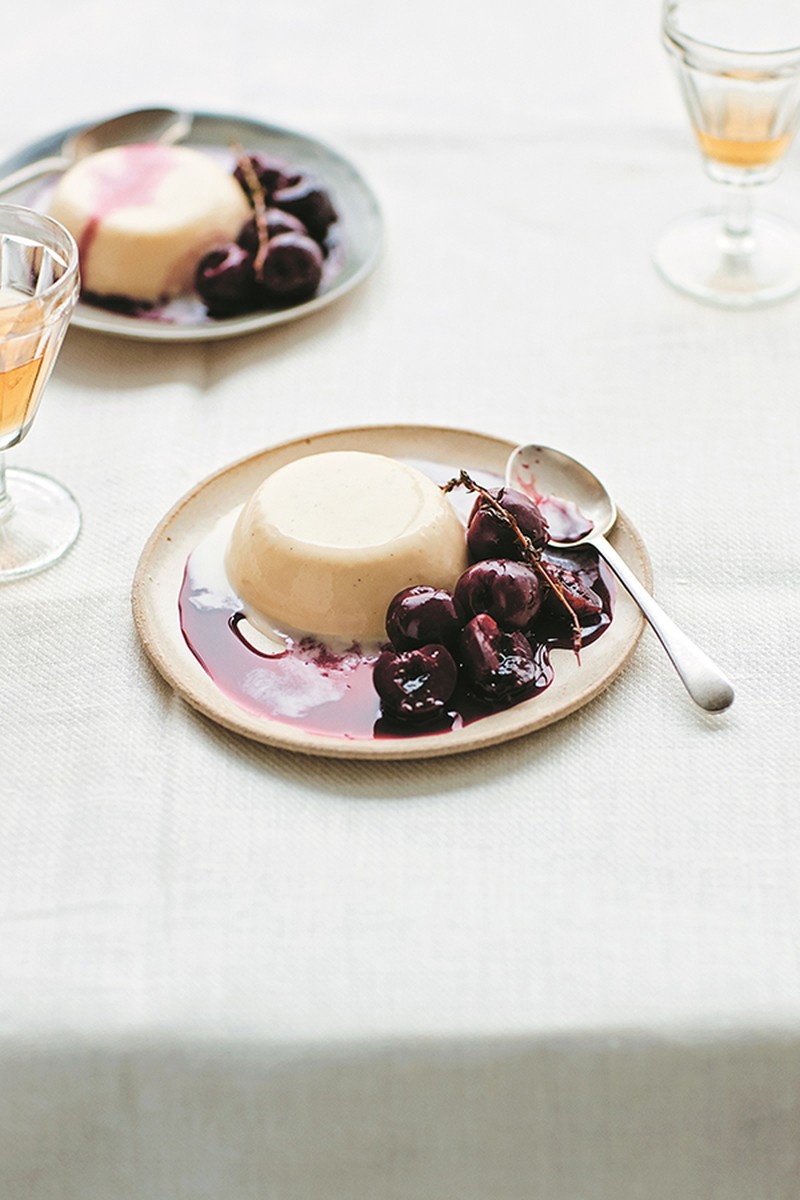
4. Pour the panna cotta mixture into your preferred moulds. I like to use individual dariole moulds that are wider than they are tall, as it makes for a prettier plate when turned out, but you can use anything you have to hand. They should be approximately 150ml/5fl oz capacity, but make do with what you have. Leave the panna cotta in the refrigerator to set for at least 2 hours.
5. To poach the cherries, bring the pastis, water and sugar to a boil with the sprig of thyme. Add the cherries. Cook at a low simmer for about 10–15 minutes, until the cherries have softened slightly and the poaching liquor has turned a deep red. Remove from the heat and allow the cherries to cool in the liquid. Refrigerate until cool.
6. To turn out the panna cotta, dip the moulds into a pot of boiling water for just a second or two. This will melt the very outside of the panna cotta and allow it to slip easily from the mould. Turn out each panna cotta into a shallow bowl, then spoon over the cherries and some of the crimson liquor.
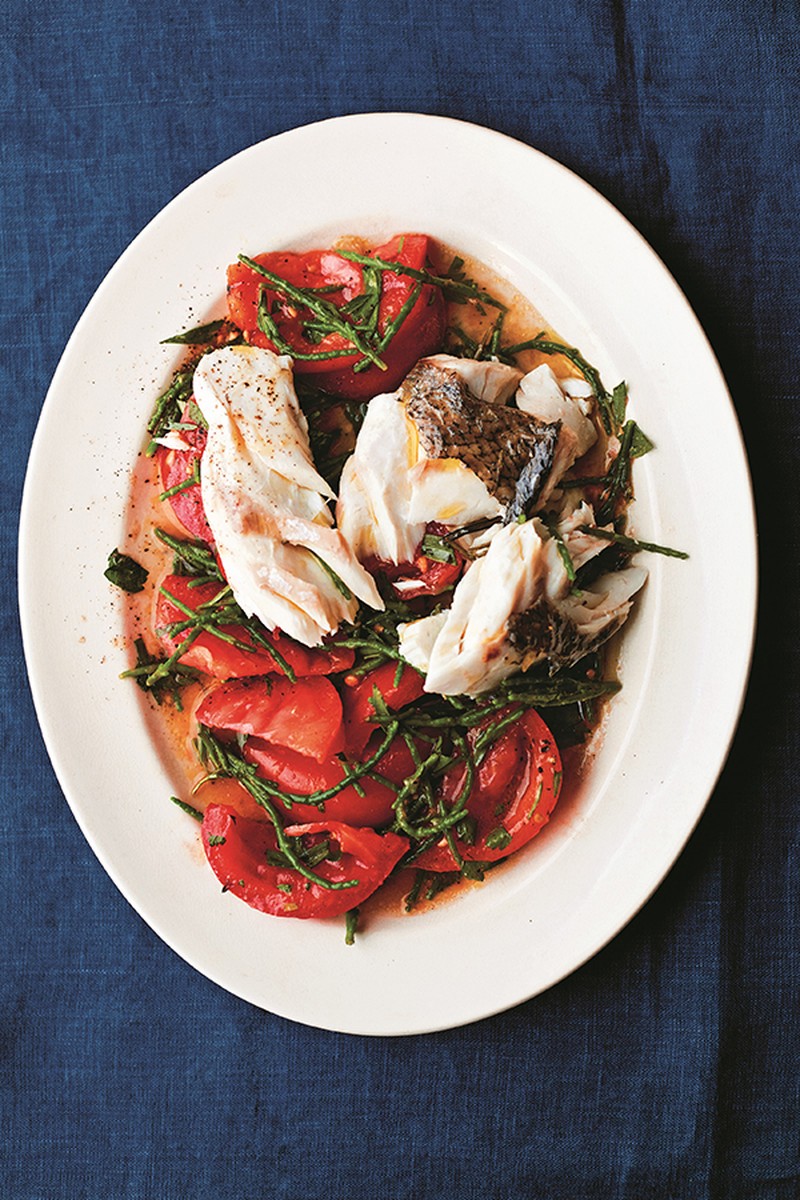
Roast Hake, Samphire & Tomato Salad
Samphire and tomatoes are, I suppose, where the British summer meets its Mediterranean counterpart. These two ingredients combine really nicely, especially when dressed with plenty of herbs, lemon juice and olive oil. Both have a pleasing juicy, succulence going on. Samphire and tomatoes pair well with any fish. Grilled oily sardines or mackerel would be great, but here I’ve chosen a pristine piece of firm hake, which flakes nicely into the salad. The fish is roasted on the bone over a bed of herbs with a little wine. Cooking it this way ensures the moist flesh can be eased off the bone. This is especially delicious with a generous blob of homemade mayonnaise or aïoli served alongside.
INGREDIENTS (Serves 4)
A fat piece of hake or any other flaky white fish, on the bone, weighing approximately 1kg scaled
2 tbsp olive oil
Branches of rosemary, thyme, bay and tarragon, all on the stalk, for a bed of herbs
1 unwaxed lemon, 1⁄2 sliced into rounds, plus 1⁄2 for juicing
200ml dry white wine
1 tbsp butter
4 juicy large tomatoes (Amalfi Italian for preference)
100g samphire, washed (this absolutely must be English or French as the imported Israeli stuff is bitter, stringy and horrible)
Olive oil
1 tbsp each roughly chopped parsley and tarragon leaves
Sea salt and freshly ground black
Pepper
METHOD
1. Preheat the oven to 180°C fan/200°C/400°F/gas mark 6. Select an appropriate size roasting dish for the fish: it needs to be a snug fit. Drizzle the dish with olive oil and build a bed of herbs. Season the hake with salt and pepper both inside and out. Nestle the fish in the herbs, slide a few slices of lemon inside the fish with some tarragon stalks too. Pour over the wine, drizzle liberally with olive oil, then dot the fish with butter.
2. Roast the hake in the oven for 20 minutes, or until the flesh offers very little resistance when pierced to the bone with a skewer. If you can, it’s best to remove the fish from the oven when it is almost cooked as it will continue to steam and cook on the bone while you assemble the rest of the dish. If the wine threatens to boil away during cooking, add a splash of water. Ideally there will be some buttery, winey juices left in the bottom of the dish.
3. To bring it all together, cut the tomatoes into fat chunks, then season with salt and pepper. Fill a large pan with water and bring to the boil. Cook the samphire in the boiling water for only a minute or two, or until soft and succulent. Do not add salt. Drain and set aside. Combine the tomatoes with the samphire, while it’s still warm, and dress them with olive oil, lemon juice and chopped herbs.
4. Arrange the still-warm tomato and samphire salad on a serving platter. Flake the hake flesh off the bone in big pieces and lay them just to the side of the salad. Drizzle any buttery, winey juices from the roasting dish over the fish.
5. A crusty baguette would do a first-class job of mopping up the juices here, making an impromptu open sandwich of warm, buttery fish and juicy tomatoes.
Sardine: Simple Seasonal Provençal Cooking by Alex Jackson is available to buy now. Visit Amazon.co.uk
DISCLAIMER: We endeavour to always credit the correct original source of every image we use. If you think a credit may be incorrect, please contact us at info@sheerluxe.com.
